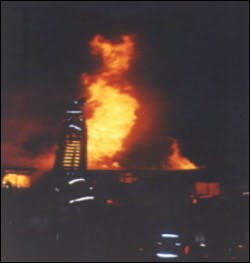Fire Ground Photography: Equipment
Have you ever been on the scene of an emergency and noticed a photographer snapping shots with a camera and lens equal in size to most SCBA bottles? It would be nice if we could all afford those $3,000.00 lenses but for the most part it isn't necessary nor for most firefighters is it affordable. The major news agencies need the large, expensive lenses that allow the most amount of light into the camera due to the different, low light, settings that their photographers shoot.
So, what type of equipment is needed for the typical fire ground photographer?
Camera- 35mm film or digital
Lens- Wide or Zoom
Flash
Film- ASA 100-800 or a media card
Camera Bag- to carry accessories
Cameras. The average fire ground photographer can get away with a "run of the mill" Point and Shoot camera. If lucky, the camera may have a small zoom built in so that the photographer can get closer to the action. For those interested in becoming creative with their photography or interested in nighttime photography, a more advanced SLR (Single-Lens-Reflex) camera is required. These cameras allow the user to set their own aperture and shutter speeds, giving the photographer the ability to stop or blur action, make silhouette and long exposure shots. SLR cameras have removable lenses, which give the photographer the ability to go from a wide-angle lens to a zoom lens in a matter of seconds. Finally, these cameras come equipped with a hot-shoe, a device attached to the top of the camera that allows the use of an accessory flash. The small flashes built into most SLR and point and shoot cameras are not powerful enough for nighttime shooting, therefore, an accessory flash is needed.
Lenses. Lenses come in different sizes for different shots. Wide-angle lenses, usually the 14-35mm range, allow the photographer to stand close to the subject and get the entire area in the shot. They allow the fire ground photographer to stand in front of the building and get the entire building in the shot. They also allow the apparatus photographer to stand just feet from a rig and get the entire apparatus in the picture. Wide-angle lenses can be very expensive. Zoom Lenses, 28-70mm range, allow the fire ground photographer to take wide-angle shots as well as zoom in, get closer, to the action. Zoom lenses are sometimes sold with SLR cameras and are great to have. Tele-photo lenses, 70-300mm range, virtually allow the fire ground photographer to get into the bucket of a tower ladder without actually being in it. These lenses are used for close-up shots when the photographer isn't allowed to get close. Camera companies do produce lenses that cover the entire 28-300mm range in one lens. One lens or a combination of lenses that cover that 28-300mm range is recommended.
Flashes. Most camera manufacturers make accessory flash units to go with their cameras. These flash units will vary in price depending on the output power of the unit, the less expensive-- the less powerful, the more expensive -- the more powerful. A powerful flash is needed to illuminate the scene of an emergency. Shots taken at night with a built-in flash will generally illuminate the reflective stripes on the responders' gear and nothing more.
Film. Film is sold with different ASA levels or speeds. Film with a low ASA number (50-100), is used for daytime or bright light photography, with virtually no grain. Grain is the particles of silver that make up a photographic image, found on an emulsion coating the film. A "grainy" photo describes a photo that has a speckled appearance due to the silver clumping together. Film in the 200-400-speed range can be used in both day and night-time situations. Advances in film technology have improved film in this area to such a degree that very little grain can be seen in an enlarged photo. Film in the 800-1600 speed range is for nighttime or low light photography and depending on the manufacturer can be grainy when enlarged. Be sure to always carry extra rolls of film and know how many shots you have left on the roll of film in your camera. It is a photojournalists worst nightmare to finally be in the right place at the right time only to find out that they have either no film or just one shot left on the roll of film in the camera.
Camera Bag. As foolish as this may sound, a good camera bag is needed to carry all of your equipment in. It provides easy access to multiple lenses, flash unit and extra batteries and rolls of film. It also keeps the sun and water spray from ruining your gear.
The above items are, in this author's opinion, required for every fire ground photographer. A person looking to get into fireground photography with an entry level camera and equipment can purchase a "kit", that includes a camera and one or two lenses. One can expect to pay between $250-400 depending on the seller. A decent flash and bag may cost another $200. Some good deals can be found on on-line auction sites. This is a big investment but of course, the camera outfit can be used to shoot subjects other than fireground photography. These are great cameras to capture the kids sporting events, nature and landscapes and every situation that you have said to yourself, "Gee, I really wish that I had a camera right now."
Related:
